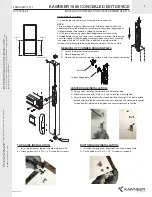
Editie 2.3 pg5
Display name:
Enter here the name of the recipient who will be assigned to a quick dial button via quick dial button
settings.
Phone number:
this is the number that the door intercom must call to be able to reach this recipient.
With the green and red buttons you can make a test call to this number.
Time profile:
you can assign a time profile to a recipient. If a call is placed to this recipient outside
the time profile, the door intercom will not launch a call
or
it will call the next recipient who does fall
within the time profile.
For instance, you can program 3 shift teams under 1 button, each with a different time profile of 8
work hours. The correct shift team will then always be called at the correct time. See the following
two points: 3.6 Quick dial Button Settings and 3.8 Time Profiles.
Call and enter:
if a relay is chosen here, this relay will be activated directly when calling this recipient.
Shorten Ring Time to (sec): :
if the square is ticked and a value is entered here, the call during Call
and Enter will only ring the telephone with that value.
This function is useful for, e.g. dentists. When calling, the door is concretely opened directly and the
telephone rings, e.g. 1 or 2 times as notification that someone is entering.
The Call and Enter function can also be used to provide contact when calling, e.g. to an input of a
home automation system. If this is the case, disable the Door open animation.
Recipients can therefore be created doubly: first without Call and Enter and then with Call and Enter
activated. You can link a different time profile to set automatic opening of the door by times. The
double recipient is then programmed under the same button and may or may not be called
depending on the time of day. The Call and Enter function then comes with the recipient.
Stop forwarding with DTMF and stop Forewarding time out
: When a call goes to voicemail, the
Wizard will see this as an answer and therefore not call the subsequent recipients. This can be
resolved by requiring the recipient to send back a code after they have answered the call.
When, e.g. * is entered in this field, then the person who answered the call must enter * within a
pre‐set time (stop forewarding time out). The conversation then remains open. If * was not entered,
then the call is interrupted and the next number from the memory is dialled.
3.5 Sip connection settings
Editie 2.3 pg6
Screen name: enter a logical name for the device. The device’s location is useful when you have
multiple door intercoms in 1 project.
The telephone number is the number of the door intercom on the external SIP server.
Domain: if empty, the SIP server field will be used.
Authentication ID and Password must match those given in the SIP server.
Server address and server port: enter the data for the external SIP server with which the door
intercom is to be integrated.
Registration status: Here you can see whether the doorphone has been registered successfully or
not. Attention: do not refresh itself after changing data! Push F5 and continue for page refresh.
Detect DTMF: for maximum compatibility, leave all these check‐marked.
Echo suppression options: it is best to leave this unchanged.
Click apply to confirm the changes.
3.6 Quick Dial Button Settings























